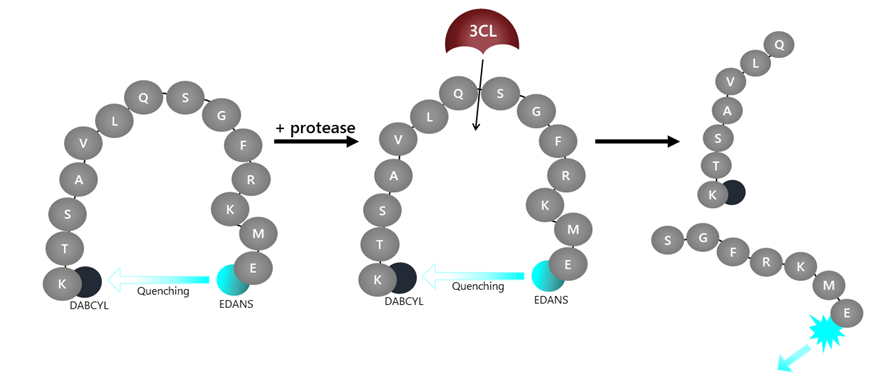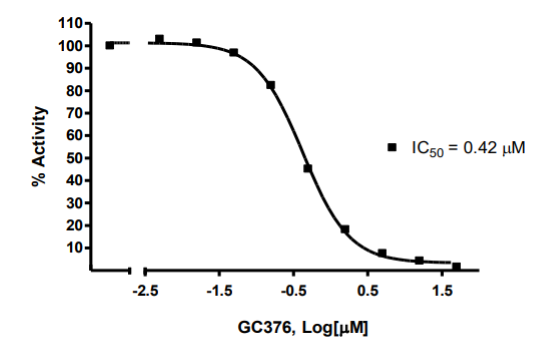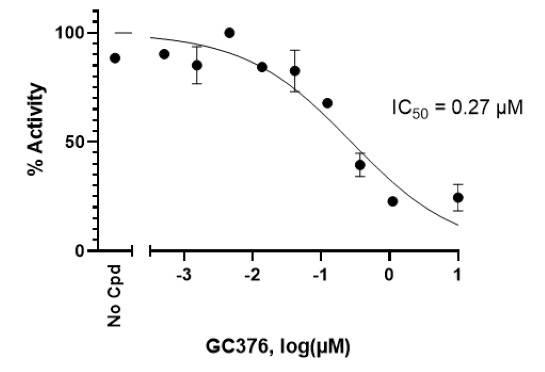3CL Protease, MBP-tagged (SARS-CoV-2) Assay Kit
The 3CL Protease Assay Kit is designed to measure 3CL Protease activity for screening and profiling applications, in a homogeneous assay with no time-consuming washing steps. The kit comes in a convenient 96-well format, with purified 3CL Protease MBP-tag (BPS Bioscience #100707), fluorogenic substrate, and 3CL Protease assay buffer for 100 enzyme reactions. 3CL inhibitor GC376 is also included as control.
The 3CL Protease Substrate is an internally quenched 14-mer fluorogenic peptide (DABCYL-KTSAVLQSGFRKME-EDANS). When the donor (EDANS) and acceptor (DABCYL) fluorophores are in close proximity, the energy emitted from EDANS is quenched by DABCYL (intact substrate). Upon proteolysis by 3CL, the peptide substrate is cleaved between glutamine and serine by the 3CL protease to generate the highly fluorescent peptide fragment (SGFRKME-EDANS). The fluorescence intensity increases proportionally to the activity of 3CL. More information on the substrate, including MW and structure, can be found on our website (BPS Bioscience #79952).
The 3CL Protease, Untagged (SARS-CoV-2) Assay Kit (BPS Bioscience #78042) demonstrates better sensitivity than the 3CL Protease, MBP-tagged (SARS-CoV-2) Assay Kit, therefore we highly recommend using #78042 for best results.

Figure 1: Illustration of the principle behind the 3CL protease assay.
The 3CL Protease Substrate is an internally quenched 14-mer fluorogenic peptide (DABCYL-KTSAVLQSGFRKME-EDANS). When the donor (EDANS) and acceptor (DABCYL) fluorophores are in close proximity the energy emitted from EDANS is quenched by DABCYL (intact substrate). Upon proteolysis by 3CL, the peptide substrate is cleaved between the glutamine and serine residues to generate the highly fluorescent peptide fragment (SGFRKME-EDANS). The fluorescence intensity increases proportionally to the activity of 3CL More information on the substrate, including MW and structure, can be found on our website (BPS Bioscience #79952).
Need us to run inhibitor screens or profile your compounds against 3CL protease (SARS-CoV-2)? Check out our Protease Screening Services or Coronavirus Services.
This product has been cited 61 times.
Fluorescent microplate reader capable of reading exc/em=360 nm/460 nm
96 Reactions:
| Catalog # | Component | Amount | Storage | |
| 100707 | Recombinant 3CL Protease, MBP-tag* | 20 µg | -80°C | Avoid freeze/ thaw cycles! |
| 79952 | 3CL Protease Substrate (10 mM) |
25 µl | -80°C | |
| 79956 | 3CL Protease Assay Buffer | 25 ml | -20°C | |
| 78013 | GC376, MW=507.5 | 50 µg | -20°C | |
| 0.5 M DTT | 200 µl | -20°C | ||
| 79685 | Black, low binding microtiter plate | 1 | Room Temp |
|
| Plate sealing film | 1 | |||
*The exact concentration of protein is lot-specific and will be indicated on the tube containing the protein.
384 Reactions:
| Catalog # | Component | Amount | Storage | |
| 100707 | Recombinant 3CL Protease, MBP-tag* | 60 µg | -80°C | Avoid freeze/ thaw cycles! |
| 79952-1 | 3CL Protease Substrate (10 mM) |
50 µl | -80°C | |
| 79956 | 3CL Protease Assay Buffer | 25 ml | -20°C | |
| 78013 | GC376, MW=507.5 | 50 µg | -20°C | |
| 0.5 M DTT | 200 µl | -20°C | ||
| 79961 | 384-well black, low binding microtiter plate | 1 | Room Temp |
|
| Plate sealing film | ||||
*The exact concentration of protein is lot-specific and will be indicated on the tube containing the protein.
Coronaviruses (CoVs) cause respiratory and intestinal infections in humans and animals. The 3CL protease, also known as Main Protease (Mpro), plays a vital role in processing the polyproteins that are translated from the viral RNA. Protease inhibitors that can block viral replication are promising potential drug candidates for the treatment of patients suffering from COVID-19 infection.
1. Jared S. Morse, et al., 2020 Chem.Bio.Chem. 21:730 – 738.
2. Zhang, L., et al. 2020, Science 368 (6489): 409-412.




